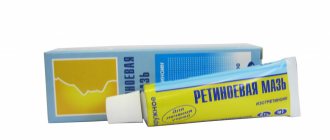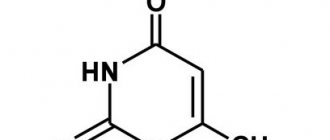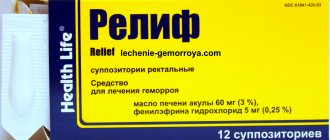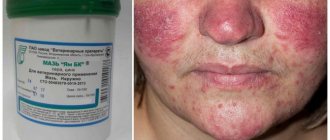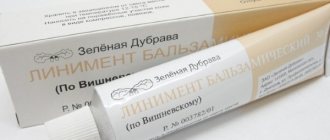This is interesting! Women living in harsh, cool or humid climates are less susceptible to wrinkles than their peers from dry areas.
What is it like to be forty years old? Obviously, every day of delay is reflected in the faces, and in the literal sense of the word. As a result, ladies who are “late for the departing train” are rushing to buy unreasonably expensive creams, tonics and other cosmetic products. But for some reason they forget that ordinary retinoic ointment for wrinkles is in no way inferior to advertised drugs with an anti-aging effect. This will be discussed in the material below.
Is it true that pharmaceutical ointments for wrinkles are more effective than creams?
Composition and release form
Retinoic ointment is a greasy, light-yellow product of uniform consistency, which contains Isotretinoin. It is this substance that determines the high biological activity of the drug. Isotretinoin belongs to the group of Retinoids and is a type of retinoic acid along with Tretinoin, which is more toxic and for this reason is rarely used.
Retinoids are substances close in structure and physiological action to Vitamin A - Retinol, and are chemically similar to it.
For clarity, the relationship between the chemical structure of vitamin A and its derivatives is shown below.
Isotretinoin is shown on the left and is completely cis-retinoic acid, that is, its chemical configuration in which the functional group is in the same plane as the double bond. Cis isomers are more reactive, i.e. have greater biological activity. In addition, it is safer than trans-retinoic acid - Tretinoin .
To date, among the six drugs registered in Russia, Isotretinoin Retinoic ointment is the only dosage form in the form of an ointment.
Therefore, if you come across a drug in the pharmacy in the form of an ointment or cream with a different name, where this active substance is indicated, then keep in mind that this is a counterfeit or fake.
The patent and rights to produce this ointment belong to the pharmaceutical industry.
Retinoic ointment is available in two concentrations:
0.5% - containing 0.05 g of Isotretinoin per 10 g of ointment and 1% containing 0.1 g, respectively.
The ointment also contains auxiliary components:
- Dibunol (antioxidant, antioxidant);
- Butyloxyanisole (antioxidant, preservative, acidity regulator);
- Emulsion wax (emulsifier);
- Vaseline oil (lipophilic base);
- Glycerin (density regulator, solvent, has a moisturizing effect on the skin);
- Ethyl alcohol (solvent, preservative);
- Purified water.
Mechanism of action
The unique components that are present in the ointment help achieve a comprehensive effect on the skin. Thanks to the use of the substance, it is possible to obtain the following effects:
- Regenerating action. The ointment ensures restoration of affected skin, helping to cope with pimples, wrinkles and acne marks.
- Anti-inflammatory effect. With the help of the product it is possible to stop inflammation.
- Keratological action. The use of the substance helps to achieve exfoliation of the epithelium. Thanks to this, dead cells are quickly removed from the surface of the epithelium and do not lead to clogging of pores.
- Sebostatic effect. The use of the composition normalizes the functioning of the sebaceous glands, which helps slow down the synthesis of subcutaneous fat.
Isotretinoin is a dermatoprotector that helps restore the epithelium, making it cleaner. The drug helps cope with wrinkles and acne. The product successfully eliminates rashes and hyperemia of the dermis. Thanks to its healing properties, it can eliminate acne and blackhead spots. The composition also copes well with scar defects.
A unique feature of the substance lies in the fact that it acts not only on the surface of the epithelium. Numerous reviews indicate that the product successfully copes with various subcutaneous formations. Moreover, the medicine is suitable not only for the skin of the face, but also for the back, shoulders, and hips.
The components of the ointment actively smooth out wrinkles. This tool provides the following results:
- Promotes epithelial renewal, copes with dead areas and keratinized cells.
- Activates collagen synthesis, which ensures the smoothness and elasticity of the epithelium.
- Promotes tissue restoration, helps cope with deep wrinkles and creases. The drug also helps smooth out a fine network of wrinkles.
Thanks to the alignment of the epithelium and the active production of collagen, it is possible to achieve noticeable rejuvenation of the epithelium.
How does Retinoic ointment work?
Compared to other Retinol derivatives, retinoic acids and Isotretinoin in particular have a shallower penetration depth, which means less absorption into the body, and therefore less likelihood of serious side effects when used exclusively externally.
Vitamin A is fat-soluble, like all its derivatives. They are always in alliance with carriers - fats and fat-like substances, which means, like all fats, they penetrate the skin well.
When to apply the product
Products with retinoids are best used at night after cleansing your face. For the first couple of weeks, apply it twice a week in the evenings. For the next two weeks, alternate two days of use with two days of rest. After four to six weeks, when the skin has become accustomed to the procedure, switch to a daily regimen. Be sure to use sunscreen throughout the day to reduce the risk of harmful UV rays.
Instagram content
This content can also be viewed on the site it originates from.
Side effects
Burns from retinoic ointment are a common side effect and consequence of retinization. Such burns usually go away on their own after short-term withdrawal of the drug. Repeated use should be resumed with a smaller amount of a lower concentration in order to allow the skin to get used to and adapt.
Retinization is the saturation of the skin with retinoid products, in other words, their “accumulation” in the skin as a result of regular use.
This concept has two consequences:
The first is stimulation of all processes of skin cell renewal;
The second is severe skin irritation, accompanied by burning, sometimes pain and even “corrosion” of the skin, which, however, is very rare when using ointment.
The latter property underlies the action of retinoic peels.
More serious side effects are associated with the effect on the fetus.
Isotretinoin, like other retinoids, can cause deformities in the fetus, i.e. is teratogenic. Even small concentrations of the drug can cause deformities, so it’s not worth the risk. Consequently, drug therapy with this substance is carried out exclusively in women who are not pregnant or planning a pregnancy, using at least two reliable methods of contraception simultaneously, both during treatment and for the next one to two months after.
No foreign doctor will prescribe this drug to you without setting the above condition. In addition, all women who use this drug, especially in the form of tablets, are entered into a special register and their health status is monitored.
But in Russia, many dermatologists neglect this rule, not to mention monitoring women’s health when using external medications, which are called almost a panacea for everything: from wrinkles to acne.
And that is not all. When treating acne in men with Isotretinoin tablets or long-term therapy and applying Retinoic ointment to large areas of the skin (larger than the palm area), the substance can penetrate into the seminal fluid, so partners are also strongly recommended to use double contraception.
Separately, I would like to say about cosmetic preparations containing retinol and its derivatives.
There are many cosmetic preparations that contain a fairly high content of retinoids, so you should always remember:
- Cosmetics are subject to less stringent requirements than drugs;
- For cosmetics, bioavailability and the percentage of the substance entering the systemic circulation are not taken into account;
- There are also associated side effects that can have an irreversible effect, and especially no one will tell you about possible teratogenicity;
- Few cosmetic preparations have detailed instructions indicating side effects and warnings, the maximum that can be written is “consult a cosmetologist, may cause an allergic reaction, in case of contact with eyes, rinse them with plenty of water”;
- You cannot know for sure what side effects are fraught with certain cosmetic products, even your cosmetologist may not know, and manufacturers simply have not studied this aspect or are silent.
Rules for conducting an allergy test
Before applying the product, you must strictly follow the manufacturer's instructions. To minimize the risk of complications and adverse reactions, it is worth doing an allergy test. The procedure is quite easy. To do this you need to do the following:
- Apply a little ointment to the bend of your elbow. It is best to choose an area where the skin is as soft and thin as possible.
- Cover the treated area with a band-aid and leave for 24 hours.
- After the specified time, remove the patch and assess the condition of the epithelium. If rashes, redness or swelling appear, do not use the product.
When performing an allergy test, you need to make sure that the skin not only shows no allergy symptoms, but also that there is no burning, tingling or peeling.
Contraindications
Retinoic ointment has clear contraindications for use, including:
- Pregnancy, including planned;
- It is also contraindicated in nursing women due to the possibility of passage into breast milk;
- Hypersensitivity and skin damage, the cause of which is not clear;
- Too thin and dry facial skin;
- Vitamin A hypervitaminosis;
- Fatty liver and lipid metabolism disorders;
- Treatment with tetracycline antibiotics;
- Treatment with other retinoids.
Combination of retinol with creams
To achieve excellent results and cope with wrinkles, you can not only use retinoic ointment, but also combine a pharmaceutical solution of vitamin A with various creams. This product can be purchased at the pharmacy in capsules or ampoules. In such dosage forms, the vitamin is presented in liquid form.
To achieve an excellent anti-aging effect, just add a little vitamin A to your regular skin care cream. It is recommended to apply the product before bedtime. In this case, it is necessary to avoid the skin around the eyes.
Indications for use
According to the official instructions for the use of Retinoic ointment, there are only a few indications for its use:
- Acne;
- Seborrheic dermatitis;
- Rosacea;
- Perioral dermatitis (“jams”, cracks in the corners of the lips).
However, given the positive effects of this ointment, there are several non-trivial indications for which it can be used, among them:
- Treatment of fresh scars, scars and stretch marks;
- Treatment of post-inflammatory hyperpigmentation, post-acne (after acne and wounds);
- Reduction of facial and age wrinkles that appear due to decreased skin turgor;
- Treatment of ingrown hairs after depilation.
Rules of application
Although this drug is intended for the skin regardless of location, Retinoic ointment is still more often used specifically for the facial skin.
Let's consider the methods and features of its use in each specific case, but before that it is worth learning a few general recommendations:
- Treatment with the drug should be started with a lower concentration, especially for those who use this drug for the first time;
- For people with very thin and sensitive skin, it is recommended to mix a small amount with Vaseline oil 1:1, gradually increasing the percentage of ointment, this way you will be able to avoid burns on the skin;
- Treatment should be continued for at least a month (as for most retinoids) provided there are no adverse reactions;
- When using Retinoic ointment under the eyes, do not apply it close to the eye, especially in high concentrations;
- When applying around the eyes, retreat 1-1.5 cm from the eye, apply in a thin layer and do not rub into the skin, but rather use the advice from step 2;
- Under no circumstances should this product be applied in the form of a mask in a thick layer over the entire face, this can lead to disastrous consequences;
- The ointment should be applied in a thin layer locally, only to the affected area, unless the doctor prescribes otherwise.
For acne and blackheads
As a remedy for acne, retinoic ointment is applied in a thin layer to the affected areas 2 times a day. It is necessary to apply the composition to cleansed, dry skin and do not cover it with creams or other products. During the treatment period, it is better for girls to avoid decorative cosmetics in the affected area. Yes, it is not easy, however, the result is worth it.
Beneficial features
Retinoic ointment is often used for skin care. It is also often used to rejuvenate the epithelium. The unique composition of the product stimulates epithelial renewal and increases its elasticity. With systematic application of the composition, the appearance of the skin noticeably improves. It becomes more tender and velvety.
The drug helps smooth out facial wrinkles. It also helps to achieve a pronounced tightening effect with increased sagging epithelium. However, such a result can only be achieved if it is used systematically.
In addition, the substance is used in the following situations:
- acne and pimples;
- dermatitis on the face;
- seborrhea;
- increased production of fat by the sebaceous glands;
- acne.
Analogs
This unique drug has many effects and indications, so for each of them we have indicated separate analogues.
For clarity, analogues of Retinoic ointment are divided into groups, which can be seen in the table.
Retasol
Isotretionin preparation in the form of a 2.5% solution for external use. Contains propylene glycol and ethyl alcohol as auxiliary components. The higher concentration is due to the liquid dosage form. The main indications are also:
- Acne;
- Seborrheic dermatitis;
- Rosacea;
- Perioral dermatitis.
Due to its higher concentration, Retasol is not recommended for use on thin and damaged skin, especially under the eyes. Also, the liquid form is less effective for use against wrinkles.
The solution must be stored in the refrigerator.
We see
It is an ointment containing Retinol - Vitamin A. The remaining components are almost the same as Retinoic ointment, only the antioxidant components differ. The compositions of the products can be compared in the table .
| Retinoic ointment | Ointment Videstim |
| Dibunol | Butylated hydroxytoluene |
| Butyloxyanisole | Butylated hydroxyanisole |
| Emulsion wax | Emulsion wax |
| Vaseline oil | Vaseline oil |
| Glycerol | Glycerol |
| Ethanol | Ethanol |
| Purified water | Purified water |
The manufacturer is also
The official instructions for Videstim ointment include a number of indications for which this product can be used, including:
- Eczema;
- Dermatitis, including atopic dermatitis in the absence of exacerbation (i.e. in remission);
- Excessive pigmentation (cheilitis), including age-related;
- Age-related skin changes (meaning wrinkles); diseases associated with impaired skin keratinization processes, such as hyperkeratosis;
- To activate skin restoration processes after glucocorticosteroid therapy.
